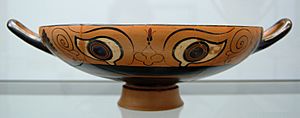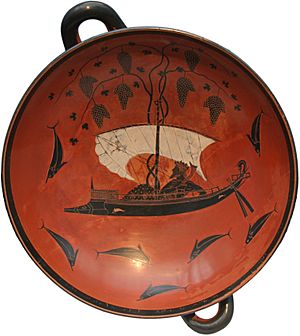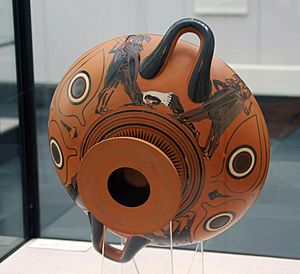Eye-cup facts for kids

An eye-cup is a special kind of drinking cup from ancient Greece. You can easily spot it because it has big pairs of eyes painted on its outside surface. These cups were very popular in cities like Athens and Chalkis around 550 to 500 BC.
Contents
What is an Eye-Cup?
Eye-cups are a type of kylix, which is a wide, shallow drinking cup. They were very common in Athens and Chalkis during the second half of the 500s BC. The cup's bowl sits on a short, wide foot. On both sides of the cup, there are large painted eyes with arched eyebrows.
The round part of the eye was usually painted black. Sometimes, it was filled with white paint or painted white on a black background. Some eyes look "female" because they are shaped like almonds and don't have tear-ducts. Often, a simple nose is painted right in the middle, between the two eyes.
How Eye-Cups Were Used
When someone drank from an eye-cup, they had to tilt it up. As they did, the cup would look like a mask! The painted eyes, the handles like ears, and the foot like a mouth would all come together. Many of these cups also show pictures related to Dionysus, who was the Greek god of wine and celebration.
People believe the eyes on the cups had a special purpose. They were thought to have an apotropaic function. This means they were supposed to scare away evil spirits or bad luck.
Different Styles of Eye-Cups
Eye-cups were painted by many different artists. Most of them used the black-figure style. In this style, the figures are painted in black silhouette against the red clay of the pot. Later, some artists started using the red-figure style. Here, the background is painted black, and the figures are left in the red color of the clay.
Bilingual Vases
Some of the earliest vases that used both styles are eye-cups. These are called bilingual vases. They might have a black-figure scene on the inside and a red-figure scene on the outside.
A famous artist named Exekias is thought to have started this bilingual style in Athens. His eye-cup, which is now in Munich, was made around 530-540 BC. It's considered a masterpiece! It shows Dionysus relaxing on a ship, like someone at a party. You can tell he's a god because a vine, which is his special symbol, grows right out of the ship's mast.
Famous Eye-Cup Artists
Many other artists and groups also painted eye-cups. Here are a few well-known ones:
- Amasis Painter: He made several eye-cups with a slightly different shape.
- Epiktetos: Known for his bilingual eye-cups.
- Hischylos
- Krokotos Group
- Leafless Group: They kept making eye-cups, but sometimes without the big eyes.
- Lydos Group
- Lysippides Painter
- Nikosthenes
- Oltos: Also painted bilingual eye-cups.
- Pheidippos: Another artist who made bilingual eye-cups.
- Skythes: Also created bilingual eye-cups.
- Group of Walters 48.42: This group often painted masks of Dionysus, or pictures of satyrs and maenads (followers of Dionysus) between the eyes. They also sometimes put scary faces called gorgoneia on the inside of the cup.
There was also a special type of eye-cup made in the Chalkidian style, with its own unique variations.
History of Eye-Cups
It can be tricky to know the exact date when each eye-cup was made. However, most of them were likely produced between 540 and 500 BC, and perhaps even up to 480 BC.
These cups were also sent in large numbers to Italy. Many eye-cups have been found in the tombs of the Etruscans, an ancient people who lived in Italy. They were often placed in graves as special items for the afterlife.
See also
 In Spanish: Copa de ojos para niños
In Spanish: Copa de ojos para niños



